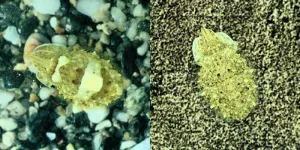(Press-News.org) A new technique developed by UCLA geologists that uses artificial intelligence to better predict where and why landslides may occur could bolster efforts to protect lives and property in some of the world’s most disaster-prone areas.
The new method, described in a paper published in the journal Communications Earth & Environment, improves the accuracy and interpretability of AI-based machine-learning techniques, requires far less computing power and is more broadly applicable than traditional predictive models.
The approach would be particularly valuable in places like California, the researchers say, where drought, wildfires and earthquakes create the perfect recipe for landslide disasters and where the situation is to expected to get worse as climate change brings stronger and wetter storms.
Many factors influence where a landslide will occur, including the shape of the terrain, its slope and drainage areas, the material properties of soil and bedrock, and environmental conditions like climate, rainfall, hydrology and ground motion resulting from earthquakes. With so many variables, predicting when and where a chunk of earth is likely to lose its grip is as much an art as a science.
Geologists have traditionally estimated an area’s landslide risk by incorporating these factors into physical and statistical models. With enough data, such models can achieve reasonably accurate predictions, but physical models are time- and resource-intensive and can’t be applied over broad areas, while statistical models give little insight into how they assess various risk factors to arrive at their predictions.
Using artificial intelligence to predict landslides
In recent years, researchers have trained AI machine-learning models known as deep neural networks, or DNNs, to predict landslides. When fed reams of landslide-related variables and historical landslide information, these large, interconnected networks of algorithms can very quickly process and “learn” from this data to make highly accurate predictions.
Yet despite their advantages in processing time and learning power, as with statistical models, DNNs do not “show their work,” making it difficult for researchers to interpret their predictions and to know which causative factors to target in attempting to prevent possible landslides in the future.
“DNNs will deliver a percentage likelihood of a landslide that may be accurate, but we are unable to figure out why and which specific variables were most important in causing the landslide,” said Kevin Shao, a doctoral student in Earth, planetary and space sciences and co–first author of the journal paper.
The problem, said co–first author Khalid Youssef, a former student of biomedical engineering and postdoctoral researcher at UCLA, is that the various network layers of DNNs constantly feed into one another during the learning process, and untangling their analysis is impossible. The UCLA researchers’ new method aimed to address that.
“We sought to enable a clear separation of the results from the different data inputs, which would make the analysis far more useful in determining which factors are the most important contributors to natural disasters,” he said.
Youssef and Shao teamed with co–corresponding authors Seulgi Moon, a UCLA associate professor of Earth, planetary and space sciences, and Louis Bouchard, a UCLA professor of chemistry and bioengineering, to develop an approach that could decouple the analytic power of DNNs from their complex adaptive nature in order to deliver more actionable results.
Their method uses a type of AI called a superposable neural network, or SNN, in which the different layers of the network run alongside each other — retaining the ability to assess the complex relationships between data inputs and output results — but only converging at the very end to yield the prediction.
The researchers fed the SNN data about 15 geospatial and climatic variables relevant to the eastern Himalaya mountains. The region was selected because the majority of human losses due to landslides occur in Asia, with a substantial portion in the Himalayas. The SNN model was able to predict landslide susceptibility for Himalayan areas with an accuracy rivaling that of DNNs, but most importantly, the researchers could tease apart the variables to see which ones played bigger roles in producing the results.
“Similar to how autopsies are required to determine the cause of death, identifying the exact trigger for a landslide will always require field measurements and historical records of soil, hydrologic and climate conditions, such as rainfall amount and intensity, which can be hard to obtain in remote places like the Himalayas,” Moon said. “Nonetheless, our new AI prediction model can identify key variables and quantify their contributions to landslide susceptibility.”
The researchers’ new AI program also requires far fewer computer resources than DNNs and can run effectively with relatively little computing power.
“The SNN is so small it can run on an Apple Watch, as opposed to DNNs, which require powerful computer servers to train,” Bouchard said.
The team plans to extend their work to other landslide-prone regions of the world. In California, for example, where landslide risk is exacerbated by frequent wildfires and earthquakes, and in similar areas, the new system may help develop early warning systems that account for a multitude of signals and predict a range of other surface hazards, including floods.
END
UCLA geologists are using artificial intelligence to predict landslides
Their newly developed method helps pinpoint which variables are most important in causing the earth to slip
2023-06-28
ELSE PRESS RELEASES FROM THIS DATE:
BMI cutoffs for total shoulder arthroplasty increase health disparities by preventing those in need from undergoing surgery
2023-06-28
In June, the American Medical Association announced a new policy that encourages physicians not to focus solely on body mass index, or BMI, as a determinant of weight and health. As a ratio of an individual’s weight and height, BMI can provide an easy and inexpensive but often misleading measure of someone’s overall health.
While this new policy is not mandatory for physicians, it is part of a growing opinion that BMI is more useful for assessing population health rather than individual ...
Marine Corps Ph.D. graduate explores uncertainty in machine learning
2023-06-28
As battlespace sensors proliferate and data increases, commanders can easily find themselves in an information paradox: drowning in data, but starving for knowledge.
U.S. Marine Corps Lt. Col. Pedro Ortiz, who graduated from the Naval Postgraduate School (NPS) on June 16 with a Ph.D. in Computer Science, focused his dissertation on this challenge to help enable rapid, effective decision-making for commanders in an era of ever-increasing sensor data and uncertainty.
“I am very interested in applying artificial intelligence and machine learning to solve warfighter problems,” ...
New research from Portland State shows climate change will increase impacts of volcanic eruptions
2023-06-28
Volcanic disasters have been studied since Pompeii was buried in 79 A.D., leading the public to believe that scientists already know why, where, when and how long volcanoes will erupt. But Jonathan Fink, volcanologist and director of PSU’s Digital City Testbed Center, said these fundamental questions remain a mystery. Fink and Idowu "Jola" Ajibade, associate professor of Geography, recently published an article about how climate change will affect the societal impacts of eruptions. Their work is part of a novel 33-paper collection in the Bulletin of Volcanology, co-edited by Fink, which attempts to track how the entire field of volcanology has ...
World’s first glue derived from industrial bio-waste will make furniture recyclable
2023-06-28
An innovative new adhesive, derived from purified and refined industrial bio-waste, should enable 90 percent of engineered wood products, such as furniture and construction boards, to become fully recyclable and helping to develop a sustainable circular economy in this sector.
Currently, formaldehyde adhesives used by manufacturers, are toxic petrochemicals that are carcinogenic in nature. This prevents recycling and incineration meaning most construction panels and furniture made from engineered wood ends up in landfill. The new adhesive, derived from extracted and purified waste is ...
McMaster University team discovers hormonal pathway that increases calorie burning during weight loss
2023-06-28
Hamilton, ON (June 28, 2023) - Researchers led by McMaster University professor Gregory Steinberg and postdoctoral research fellow Dongdong Wang have uncovered a key mechanism for promoting weight loss and maintaining the burning of calories during dieting.
The research team studied a hormone called GDF15 that they had previously shown to reduce appetite in response to the type 2 diabetes drug metformin. Their latest findings, published in Nature on June 28, showed that GDF15 also has the potential to help with weight loss.
The research opens new possibilities to help people maintain weight loss ...
Cuttlefish camouflage: more than meets the eye
2023-06-28
Cuttlefish, along with other cephalopods like octopus and squid, are masters of disguise, changing their skin color and texture to blend in with their underwater surroundings.
Now, in a study published 28 June in Nature, researchers at the Okinawa Institute of Science and Technology (OIST) and the Max Planck Institute for Brain Research have shown that the way cuttlefish generate their camouflage pattern is much more complex than previously believed.
Cuttlefish create their dazzling skin patterns by precisely controlling millions of tiny skin pigment cells, ...
Outcomes of financial penalties to encourage hospital price transparency
2023-06-28
About The Study: Hospital compliance with federal price transparency regulations is high and increasing. The results of this study suggest that financial penalties may be a useful policy enforcement mechanism in health care. These findings are relevant for the enforcement of other regulations designed to promote transparency in health care.
Authors: Yunan Ji, Ph.D., of Georgetown University in Washington, D.C., is the corresponding author.
To access the embargoed study: Visit our For The Media website at this link ...
Brain volume changes in aging individuals with normal cognition
2023-06-28
About The Study: In this study of adults without dementia, age-dependent brain structure volumes and volume change rates in various brain structures were characterized using serial magnetic resonance imaging scans. These findings clarified the normal distributions in the aging brain, which are essential for understanding the process of age-related neurodegenerative diseases.
Authors: Shohei Fujita, M.D., Ph.D., of the University of Tokyo, is the corresponding author.
To access the embargoed study: Visit our For The Media website at this link https://media.jamanetwork.com/
(doi:10.1001/jamanetworkopen.2023.18153)
Editor’s Note: Please ...
Long-range neuronal connections drive glioblastoma invasion
2023-06-28
Glioblastoma (GBM) is the most aggressive and lethal form of brain tumor. Despite treatment, GBM recurrence is inevitable and tends to occur outside surgical margins or in locations remote to the primary tumor, highlighting the central role played by tumor infiltration in this malicious disease.
Little is known about the underlying molecular mechanisms driving GBM infiltration, but in a new study published in the journal Nature, researchers at Baylor College of Medicine working with animal models reveal a novel process by which neurons in locations remote to the primary tumor provoke expression of genes from gliomblastoma that subsequently ...
Largest-ever atlas of normal breast cells brings unprecedented insights into mammary biology
2023-06-28
HOUSTON ― A new study led by researchers at The University of Texas MD Anderson Cancer, University of California, Irvine and Baylor College of Medicine has created the world’s largest and most comprehensive map of normal breast tissue, providing an unprecedented understanding of mammary biology that may help identify therapeutic targets for diseases such as breast cancer.
The Human Breast Cell Atlas, published today in Nature, used single-cell and spatial genomic methods to profile more than 714,000 cells from 126 women. The breast atlas highlights 12 major cell types ...
LAST 30 PRESS RELEASES:
UVA’s Jundong Li wins ICDM’S 2025 Tao Li Award for data mining, machine learning
UVA’s low-power, high-performance computer power player Mircea Stan earns National Academy of Inventors fellowship
Not playing by the rules: USU researcher explores filamentous algae dynamics in rivers
Do our body clocks influence our risk of dementia?
Anthropologists offer new evidence of bipedalism in long-debated fossil discovery
Safer receipt paper from wood
Dosage-sensitive genes suggest no whole-genome duplications in ancestral angiosperm
First ancient human herpesvirus genomes document their deep history with humans
Why Some Bacteria Survive Antibiotics and How to Stop Them - New study reveals that bacteria can survive antibiotic treatment through two fundamentally different “shutdown modes”
UCLA study links scar healing to dangerous placenta condition
CHANGE-seq-BE finds off-target changes in the genome from base editors
The Journal of Nuclear Medicine Ahead-of-Print Tip Sheet: January 2, 2026
Delayed or absent first dose of measles, mumps, and rubella vaccination
Trends in US preterm birth rates by household income and race and ethnicity
Study identifies potential biomarker linked to progression and brain inflammation in multiple sclerosis
Many mothers in Norway do not show up for postnatal check-ups
Researchers want to find out why quick clay is so unstable
Superradiant spins show teamwork at the quantum scale
Cleveland Clinic Research links tumor bacteria to immunotherapy resistance in head and neck cancer
First Editorial of 2026: Resisting AI slop
Joint ground- and space-based observations reveal Saturn-mass rogue planet
Inheritable genetic variant offers protection against blood cancer risk and progression
Pigs settled Pacific islands alongside early human voyagers
A Coral reef’s daily pulse reshapes microbes in surrounding waters
EAST Tokamak experiments exceed plasma density limit, offering new approach to fusion ignition
Groundbreaking discovery reveals Africa’s oldest cremation pyre and complex ritual practices
First breathing ‘lung-on-chip’ developed using genetically identical cells
How people moved pigs across the Pacific
Interaction of climate change and human activity and its impact on plant diversity in Qinghai-Tibet plateau
From addressing uncertainty to national strategy: an interpretation of Professor Lim Siong Guan’s views
[Press-News.org] UCLA geologists are using artificial intelligence to predict landslidesTheir newly developed method helps pinpoint which variables are most important in causing the earth to slip





